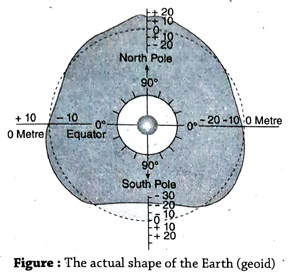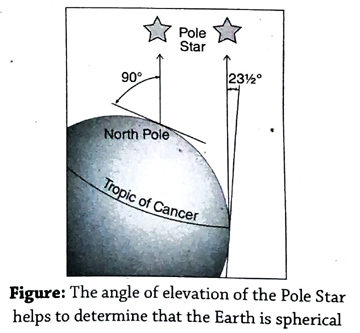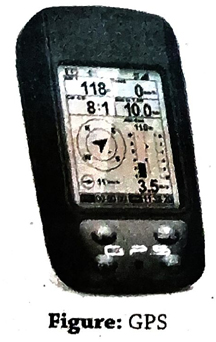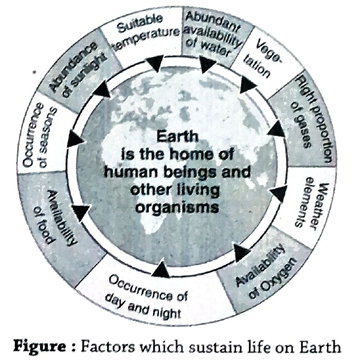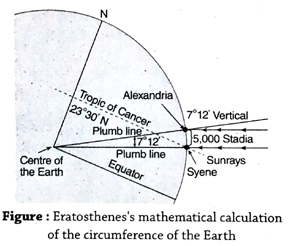WBBSE 9th Class Social Science Solutions Geography & Environment Chapter 1 Earth as a Planet
West Bengal Board 9th Class Social Science Solutions Geography & Environment Chapter 1 Earth as a Planet
WBBSE 9th Class Geography & Environment Solutions
Salient points – At a Glance
- In ancient times, people thought that the Earth was flat and in Greek civilisation people considered that the Earth was flat rounded as a disc.
- According to Greek scholar Anaximander, Earth was a floating disc in ocean which was surrounded by the round sky.
- The Portuguese globetrotter, Ferdinand Magellan had given the first direct evidence in favour of the concept-‘the Earth is round’.
- From the space, the Earth appears blue in colour because waterbodies cover 71% of the Earth’s surface.
- Greek philosopher, Aristotle stated the concept of the Earth being a sphere by observing the relative position of the stars and the shadow of the Earth that falls on the Moon during a lunar eclipse.
- To prove the spherical shape of the Earth, Bedford Level experiment was conducted in 1870.
- The boundary where the sky seems to meet the ground or the sea is known as horizon.
- A spherical object that is flattened at the top and bottom (north-south) and bulged out at the middle or centre (east-west), is defined as an oblate spheroid.
- The equatorial and polar diameter of the Earth are 12757km and 12714 km respectively.
- On the Earth’s surface, gravitational force is lowest at the Equator and maximum at the Poles.
- Scientist Henry Cavendish first determined the Earth’s weight.
- ‘Geoid’ means-like the Earth or shape of the Earth is like the Earth itself.
- The first person to use the word ‘geoid’ was Johann Benedict Listing.
- The Science related to measuring the shape of the Earth is called Geodesy.
- IAU (International Astronomical Union) listed the Pluto as a dwarf planet in 2006.
- In ancient days, the distance measurement unit used in Greece was called stadia. 1 stadia = 185 metres.
- The Pole Star’s angle of elevation is 90° at North Pole and 0° at Equator i.e. the Pole Star is visible at the horizon in Equator.
- The light of the Sun takes 8.2 minutes to reach the Earth.
- The area of the Earth’s surface is about 510 million sq.km.
- Actual circumference of the Earth is about 40075 km.
- South Pole of the Earth is about 20m flat.
- The average temperature of the Earth is about 15°C.
- The average density of the Earth is 5.515 gram/cubic centimetre.
- Full form of GPS is Global Positioning System. GPS helps to know the exact or correct location of any place on the Earth surface.
TOPIC – A
Shape of the Earth
Long Answer Type Questions
1. ‘The Earth is not flat, it is almost spherical. -Discuss with evidence.
Ans. Evidences of the Earth being flat: Though in ancient times the Earth was believed to be a flat plane or a disc, it is actually almost spherical in shape. In fact, an oblate spheroid to be precise. A practical demonstration of the Earth’s spherical shape was proved by Magellan’s circumnavigation of the Earth (1519-1522). Recent photographs taken from outer space have also shown that the Earth is spherical in shape. Some other points in support of this view are-
- The study of other planets: When other planets of our solar system have been studied through powerful telescopes, all of them have been observed to be spherical. Since the Earth is also a part of the solar system, it stands to reason that the Earth would also be spherical like the other planets.
- The study of the Earth’s shadow: When one studies the shadow of the Earth that falls on the Moon during a lunar eclipse, it is seen to be circular in shape. If an object casts a shadow that is circular in shape, it
stands to reason that the object itself is also circular in shap
- Observing a ship sailing out to sea: If we observe a ship that has just set sail from the shore, we will see that the ship is not visible
after some time even with the help of binoculars or telescopes. This happens because of the curvature of the Earth’s surface. If the Earth would have been a flat plane, the ship would never disappear from our line of sight.
- Observing the horizon: The boundary where the sky seems to meet the ground or the sea is known as the horizon. The visible horizon marks the end of our line of sight. As we go higher up in an aeroplane or up a
mountain, the visible horizon becomes more distant and its circumference seems to increase. As a result of which the line of horizon appears circular. If the Earth would have been a flat plane, the circumference of the line of horizon would not increase with increase in altitude of the position of the observer; instead, it would have remained the same.
- Bedford Level Experiment: In 1870, renowned naturalist and surveyor Alfred Russel Wallace (A.R. Wallace) put in 3 sticks of equal height and diameter in a straight line at 1kilometre interval in the Bedford Canal in the United Kingdom. Through a
telescope, he then observed that the second stick seemed to be higher than the first and third sticks. This proved that the Earth is round. If the Earth would have been flat, the tops would have been in a straight line.
- Sunrise and sunset: The spherical shape of the Earth causes the countries in the eastern hemisphere to experience sunrise and sunset earlier than those in the western hemisphere.
If the Earth would have been flat then sunrise and sunset would have occured at the same time at all places on the Earth.
2. Why is the Earth called an oblate spheroid? Give reason for your answer.
Ans. Reasons for the Earth being an oblate spheroid: A sphere that has a bulged-out centre and flattened Poles is defined as an oblate spheroid. The equatorial region of the Earth is bulged out and the polar regions are flattened due to the rotation of the Earth, and this is why the Earth is considered as an oblate spheroid.
There are some evidences which prove that the Earth is an oblate spheroid. They are-
- Polar diameter is less than equatorial diameter: The equatorial diameter of the Earth is 12,757 km whereas the polar diameter is 12,714 km. If the Earth would
have been a perfect sphere, then both the diameters would have been the same.
- Difference in time given by the same pendulum clock: In 1671 the French astronomer, Jean Richer, observed that his pendulum clock was running 2½ minutes slower when he was in Cayenne (5°N), the capital of French Guiana, in South America. However, the same pendulum clock would show the correct time when in Paris (49°N). This is because the time period of oscillation of the pendulum depends on the gravitational pull of a particular place, which is different in different places.
Sir Isaac Newton used this example later to show that places nearer to the centre of the Earth experience stronger gravitational pull. This confirms that Earth’s equatorial radius is greater than its polar radius-or that the Earth is oblate spheroid in shape.
- Rotational movement of the Earth: When a spherical object rotates continuously, a centrifugal force acts on it. Therefore, the middle part bulges out and at
the same time, the polar areas flatten. The Earth is continuously rotating on its axis from the time of its origin. This is why the Earth has become an oblate spheroid in shape.
- Variation in weight: The regions that are closer to the centre of the Earth experience greater gravitational pull than those farther away from the centre. Since the Earth is an oblate spheroid, the Poles are closer to the centre of the Earth and thus experience greater gravitational force. As a result, all objects weigh more at the Poles than at the Equator.
- Variation in curvature: Oblate spheroids have varying curvature from north to south. It is observed that, smaller the circle, greater is the curvature. In case of the Earth, the curvature is observed to be lesser at the Equator than at the Poles. This means that the Earth is bulged out at the centre and flattened at the Poles. Therefore, from the variation in curvature, we can deduce that the Earth is an oblate spheroid.
3. ‘The shape of the Earth is like the Earth itself.’-Explain.
Ans. The shape of the Earth is like the Earth itself: When a spherical object rotates continuously a centrifugal force acts on it. Therefore, the middle part bulges out and at the same time the polar areas flatten. As the Earth is continuously rotating on its axis from the time of its origin, the oblate spheroid shape has formed. But further studies revealed that the shape of the Earth is not a perfect oblate spheroid either. This is because of some specific reasons. They are
- Various types of landforms such as mountains, hills, plateaus, valleys and rifts are present on the Earth’s surface. Apart from these, the waterbodies with their waves, high and low tides also exist. The highest point on the Earth’s surface is Mount Everest (8,848 m) and the lowest point is Challenger Deep (10,994 m) at Mariana Trench in the Pacific Ocean. Both waterbodies and continents exist around the equatorial region at different places. Therefore, all these prove the surface of the Earth is undulating and uneven.
- Recent data from artificial satellites show that-
- The South Pole of the Earth is more flattened than the North Pole.
- The North Pole is about 20m higher and the South Pole is 20m lower than a perfect oblate spheroid shape. If it would have been a perfect oblate spheroid, both would have been at the same height.
- The latitudinal circumference is 8m more in the southern hemisphere than in the northern hemisphere.
Therefore, the shape of the Earth cannot be compared to the shape of any other object on the Earth. So, it can be said that the shape of the Earth is like the Earth itself or the shape of the Earth is ‘geoid’.
Short Explanatory Answer Type Questions
1. Why does the curvature of the circumference of the Earth gradually increase from the Equator to Poles?
Ans. In 1737, Royal Academy of Science of France did a test to calculate the correct size, shape, circumference, etc. of the Earth. Hence, the academy accurately measured a certain curvature of the circumferences of the Earth’s three cities like Quito (0°), Paris (49°N) and Lapland (68°N). It was seen that the length of curvature in Quito city is lowest. Medium in Paris and highest in Lapland. That means the length of the curvature of the circumference of the Earth gradually increases from Equator to Poles. This proves that equatorial area of the Earth is bulged out and Poles are flattened. For this, length of the curvature is less in the equatorial region and greater in the Poles.
2. What roles have gravitational and centrifugal force played in shaping the Earth as we know it today?
Ans. Gravitational and centrifugal forces have prominent effect on the shape of the Earth. Since the distance of the equatorial region is the farthest from the centre of the Earth, the effect of gravity around the equatorial region is the least. Thus, the objects tend to move outwards and away from the centre of gravity causing the central part to bulge out. On the other hand, the distance from the centre of the Earth and the effect of rotational force at the Poles is the least. Thus, the effect of gravity becomes maximum, and objects are pulled towards the centre of the Earth. As a result the Poles have gotten flattened.
Thus, the effect of two opposite forces have resulted in the geoid shape of the Earth.
3. How can a pendulum clock be used to confirm the oblate spheroid shape of the Earth?
Ans. In 1671, the French astronomer Jean Richer observed the speed of pendulum in a few places on the Earth. He noticed that his pendulum clock was running 2½ minutes slower when he was in Cayenne Island (5° N), in South America, the capital of French Guiana. However, the same pendulum clock would show the correct time when he was in Paris (49° N) the capital of France in Europe. This is because, the time period of oscillation of the pendulum changes due to the difference in the gravitational pull that occurs with change in latitude. If the time period of oscillation of the pendulum clock at Cayenne is greater than at Paris, it implies that the gravitational force of the Earth is lower at Cayenne, indicating that Cayenne is at a greater distance from the centre of the Earth than Paris. This confirms that the Earth’s equatorial radius is greater than its polar radius or that the Earth’s shape is that of an oblate spheroid.
4. How will you prove that the Earth is not an ideal oblate spheroid?
Ans. The Earth is a sphere that has a bulged out centre and flattened Poles. That is why, the Earth is a known example of an oblate spheroid. Its east-west (along the Equator) extension is a little more and circumference of north-south is relatively less. But, the Earth is not an ideal oblate spheroid, because-
- Satellite images have revealed that the North Pole of the Earth is 20 metres high and the South Pole is 20 metres flat. Again, the middle of the northern hemisphere is 8 metres flat and the middle of the southern hemisphere is 8 metres bulged.
- The surface of the Earth is not flattened everywhere. There are high points on the Earth’s surface like Everest (8848 m) and even lowest points like Mariana Trench (10916 m) in the Pacific Ocean.
5. The Pole Star’s angle of elevation helps to determine that the Earth is spherical in shape.-Explain.
Ans. The angle of elevation of the Pole Star helps to know that the Earth is round. The Pole Star is visible at different angles of elevation from different places on the Earth’s surface in the northern hemisphere. At the Equator, it is visible at 0°, from the Tropic of Cancer at 23½°, and from the North Pole at 90°.
This happens only because the Earth is spherical. Had the Earth been just a plane, the Pole Star would have been visible at the same angle of elevation from all the places on Earth.
Short Answer Type Questions
1. What is meant by Geodesy?
Ans. Geodesy is a scientific discipline that deals with the different methods of survey and other measurements to study the shape and size of the Earth.
2. What is meant by ‘geoid’?
Ans. The word ‘geoid’ is taken from the Greek word ‘geoeides’. ‘Geo’ means ‘Earth’ and ‘oeides’ means ‘similar to’. Therefore, geoid means ‘similar to the Earth’ or ‘like the Earth’.
3. Why is the Earth’s equatorial diameter not equal to its polar diameter?
Ans. The equatorial region of the Earth experiences centrifugal force and so, it bulges out. On the other hand, the polar regions experience centripetal force and so, are flattened. Therefore, the equatorial diameter of the Earth is not equal to that of the polar diameter.
4. What is meant by horizon?
Ans. The boundary where the sky seems to meet the ground or the sea is known as the horizon. The higher the observer places himself on a place, the longer the horizon becomes.
5. Which experiment of Magellan proved that the Earth is spherical?
Ans. The Portuguese explorer Magellan, set off on an expedition to circumnavigate the Earth from east to west. After three years, he came back to the same place from where he had started. This proved that the Earth is spherical in shape, because, had it not been so, he would not have come back to the same place that he had started from.
6. Where is the Kuiper Belt located?
Ans. The ring of icy bodies that revolves around the Sun beyond the orbit of Neptune is known as the Kuiper Belt. The outer limit of the Kuiper Belt is poorly defined. It contains some big heavenly bodies such as Eris, Pluto as well as millions of other smaller bodies.
7. What are the effects of centrifugal force on the Earth?
Ans. When a spherical object rotates continuously a centrifugal force acts on it. Therefore, the middle part bulges out, and at the same time the polar areas flatten. The Earth is continuously rotating on its axis from the time of its origin. This is the reason why the Earth has a bulged-out middle part and flattened Poles, i.e., it has developed an oblate spheroidal shape.
8. ‘Curvature of the Earth’s surface is lesser at the Equator than at the Poles.-Explain.
Ans. The Earth bulges out at the centre and gets flattened at the Poles. Therefore, the Earth forms an oblate spheroid. Oblate spheroids have varying curvature from north to south. It is observed that, smaller the circle, greater the curvature. This is why the curvature of the Earth’s surface is lesser at the Equator than at the Poles.
9. Why the gravitational force is more at the polar regions than at the equatorial region?
Ans. The Earth is not a perfect sphere, it is an oblate spheroid. It’s equatorial diameter is 12,757 km and its polar diameter is 12,714 km, which means there is a difference of 43 km between the lengths of these two diameters. As the Poles are closer to the centre of the Earth than the Equator, greater gravitational force is exerted on the polar regions.
10. Why an object weighs more at the Poles than at the Equator?
Ans. The regions that are closer to the centre of the Earth experience greater gravitational pull than those farther away from the centre. Since the Earth is an oblate spheroid, the Poles are closer to the centre of the Earth and thus, experience greater gravitational force. As a result, all objects weigh more at the Poles than at the Equator.
Multiple Choice Type Questions [MCQ type]
Write the correct answer from the given alternatives
1. The Earth’s equatorial diameter is-
A. 12,712 km
B. 12,745 km
C. 12,757 km
D. 12,500 km
Ans. C
2. The Earth’s polar diameter is
A. 12,400 km
B. 12,714 km
C. 12,700 km
D. 12,720 km
Ans. B
3. “The Earth revolves around the Sun.” This was first stated by-
A. Galileo
B. Copernicus
C. Aryabhatta
D. Varahamihir
Ans. C
4. The highest point on the surface of the Earth is-
A. Mount Everest
B. Pamir Plateau
C. Tibetan Plateau
D. North Pole
Ans. A
5. The deepest known point on the Earth is-
A. Mariana Trench
B Sunda Trench
C. St. Louis Trench
D. South Pole
Ans. A
6. The difference between the Earth’s polar diameter and the equatorial diameter is-
A. 40 km
B. 42 km
C. 43 km
D. 45 km
Ans. C
7. The Bedford Canal Experiment was carried out by-
A. Wallace
B. Torricelli
C. Foucault
D. Galileo
Ans. A
8. The average circumference of the Earth is-
A. 40,400 km
B. 40,075 km
C. 40,500 km
D. 40,200 km
Ans. B
9. In ancient times, people believed that the Earth was a-
A. sphere
B. oblate spheroid
C. plane
D. square
Ans. C
10. The ancient Mesopotamians believed that the Earth was-
A. floating in space
B. floating on an ocean
C. a single entity standing on its own
D. not floating anywhere
Ans. B
11. “The Earth is round.” This statement was first made by-
A. Plato
B. Pythagoras
C. Aristotle
D. Strabo
Ans. B
12. Pythagoras was a-
A. Greek philosopher
B. Roman philosopher
C. British philosopher
D. Portuguese philosopher
Ans. A
13. The first empirical proof that the Earth is round was given by-
A. Pythagoras
B. Magellan
C. Columbus
D. Aristotle
Ans. B
14. An example of the proof that the Earth is round is-
A. the view from the mast of a ship
B. travelling around the world in a ship
C. photographs taken from space
D. the view from the top of Mt. Everest
Ans. C
15. The person to calculate the Earth’s circumference on the basis of the difference in the angle of incidence of Sun rays was-
A. Strabo
B. Aristotle
C. Eratosthenes
D. Plato
Ans. C
16. The Old Bedford River is in-
A. England
B. France
C. Germany
D. Italy
Ans. A
17. The Earth can be called an oblate spheroid because-
A. the Earth’s surface is elevated by 15m at the North Pole
B. there is more water at the equatorial region
C. the highest point on Earth is Mt. Everest
D. the Poles are flattened and the equatorial region is bulging out
Ans. D
18. The Earth’s gravitational force is greatest-
A. at the equatorial region
B. in the ocean beds
C. on mountain peaks
D. at the Poles
Ans. D
19. The pendulum clock experiment was conducted by-
A. Pythagoras
B. Eratosthenes
C. Jean Richer
D. Galileo
Ans. C
20. The word ‘geoid’ means-
A. oblate spheroid
B. perfect sphere
C. flattened
D. like the Earth
Ans. D
21. One of the believers in the Earth-centric model of the universe was-
A. Copernicus
B. Aristotle
C. Bruno
D. Brahe
Ans. B
22. The telescope was invented by-
A. Kepler
B. Galileo
C. Newton
D. Halley
Ans. B
23. If we move 111.3 kilometres from the Equator towards the Poles, the angle of incidence of Sun’s rays will increase by-
A. 1° 30′
B. 2° 30′
C. 1°
D. 1° 02′
Ans. C
24. The latitudinal coordinate of Paris is-
A. 26° 32′ N
B. 47° N
C. 49° N
D. 75° 03′ N
Ans. C
25. The Cayenne Islands are in-
A. North America
B. South America
C. Asia
D. Austria
Ans. B
26. The deepest point in the Mariana Trench has a depth of-
A. 10,053 m
B. 11,035 m
C. 11,350 m
D. 10,994 m
Ans. B
27. The Earth’s centrifugal theforce is greatest at the-
A. equatorial region
B. tropics
C. polar regions
D. frigid zone
Ans. B
28. During a lunar eclipse, the shadow of the Earth on the Moon looks-
A. straight
B. curved
C. circular
D. rectangular
Ans. C
29. As we go higher up from the surface of the Earth, the line of horizon appears-
A. shorter
B. longer
C. stays the same
D. none of the above
Ans. B
30. Eratosthenes was-
A. a Roman philosopher
B. a Greek philosopher
C. an Egyptian philosopher
D. an Indian philosopher
Ans. B
31. Real shape of the Earth is-
A. spherical
B. flat
C. oblate spheroid
D. rectangular
Ans. C
32. Columbus was a tourist from –
A. France
B. Japan
C. Portugal
D. Spain
Ans. D
Very Short Answer Type Questions
Fill in the blanks with suitable words
1. The Earth’s equatorial diameter is ………. than it’s polar diameter.
Ans. greater
2. The Earth is divided equally into ……… lines of longitude.
Ans. 360
3. The Earth is an …….. spheroid.
Ans. oblate
4. Magellan started his expedition from the city of …….. in Spain.
Ans. Seville
5. ……… was the first person to observe that the Earth was round after observing the relative position of some stars.
Ans. Aristotle
6. The Bedford Canal Experiment proves that the Earth is ……….
Ans. spherical
7. The ……… Star is visible from any point in the northern hemisphere.
Ans. North/ Pole
8. The Earth’s North and South Poles are ……….
Ans. slightly flattened
9. The Earth’s equatorial diameter is ……… km.
Ans. 12,757
10. The Earth’s polar diameter is ……… km.
Ans. 12,714
11. In the year ………, Jean Richard conducted the pendulum experiment.
Ans. 1671
12. In ancient Greek civilisation people thought that the Earth is ………..
Ans. flattened
If the statement is true, write ‘T’ and if false, write ‘F’ against the following
1. The shape of the Earth is geoid.
Ans. T
2. The average diameter of the Earth is 12,800 kilometres.
Ans. F
3. The Earth’s orbit is elliptical in shape.
Ans. T
4. If the Earth was a flat plane, sunrise and sunset would occur at the same time at every place on Earth.
Ans. T
5. The weight of any object is always lesser at the Poles.
Ans. F
6. The shape of the Earth is an oblate spheroid because of centrifugal force.
Ans. T
7. The gravitational force acting on the city of Paris is stronger than that at the Cayenne Islands.
Ans. T
8. The Pole Star can be seen even from the southern hemisphere.
Ans. F
9. The Pole Star is located at an angle of 90° from the Equator.
Ans. F
10. The gravitational force acting on the Earth is the same at all latitudes.
Ans. F
11. Lapland city is situated at 60°N latitude.
Ans. F
Answer in one or two words
1. What is the meaning of ‘geoid’?
Ans. Like the Earth.
2. Which is the deepest point on the Earth?
Ans. Challenger Deep in Mariana Trench.
3. At which point will the angle of elevation of the North Star be 90°?
Ans. North Pole.
4. In which region is the gravitational force of the Earth felt the least?
Ans. Equatorial region.
5. Where is the Earth’s diameter the greatest?
Ans. Equatorial region (about 12,757 km).
6. Where was the Bedford Level Experiment conducted?
Ans. Bedford Canal on Old Bedford River in England.
7. What is the shape of the Earth really like?
Ans. Geoid,
8. Which motion of the Earth has caused the middle portion to bulge out?
Ans. Rotation.
9. What does the science of ‘Geodesy’ study?
Ans. The Earth’s shape and size.
10. Who was the first person to use the word ‘geoid’?
Ans. Johann Benedict Listing.
11. What is the estimated age of the Earth?
Ans. About 4600 million years.
12. How does the circumference of the horizon change as we go higher above the surface?
Ans. The circumference of the horizon increases.
13. What is the Kuiper Belt?
Ans. A region of icy objects beyond the orbit of Neptune.
TOPIC – B
Size of the Earth
Long Answer Type Questions
1. Discuss the main planets of our solar system.
Ans. The main planets of our solar system: Solar system is the name given to the Sun and the various planets, satellites, comets, asteroids and other heavenly bodies that move in their unique orbits around the Sun in space. The names of the planets and their characteristics are listed in the table below.
| Planet |
Distance from the Sun (km) |
Equatorial diameter (km) |
Duration of rotation |
Duration of revolution |
Special characteristics |
| 1. Mercury |
57.9 million |
4,879 |
58 days 17 hours |
88 days |
1. Mercury is nearest to the Sun.
2. It has no satellite.
3. It is also the smallest planet in the solár system.
|
| 2. Venus |
108.2 million |
12,104 |
243 days |
225 days |
1. Venus has a carbon dioxide rich atmosphere.
2. It does not I have any satellite.
3 Venus revolves from east to west.
|
| 3 Earth |
149.6 million |
12,757 |
23 hours 56 minutes 4 seconds |
365 days 6 hours |
1. Earth is the only planet which has life on it.
2. It has one satellite called Moon.
3. Earth is also known as the Blue Planet.
|
| 4. Mars |
227.9 million |
6,792 |
24 hours 37 minutes |
687 days |
1. Mars has a nitrogen rich atmosphere.
2. It has an iron rich soil cover, which makes it appear red in colour. This is why Mars is also known as the Red Planet.
3. The temperature of this planet is almost like the Earth. That is why, scientists are working hard to find the existence of life on this planet.
|
| 5. Jupiter |
778.6 million |
1,42,984 |
9 hours 50 minutes |
11 years 318 days |
1. Jupiter is the largest planet in the solar system.
2. Jupiter is called the ‘King of Planets’.
3. The gravitational power of this planet is maximum.
|
| 6. Saturn |
1433 million |
1,20,536 |
10 hours 14 minutes |
29 years 6 months |
1. Saturn is surrounded by millions of tiny objects like, dust, comets, rocks, ice, etc. which form a ring like structure around it.
2. There are seven rings around Saturn.
3. Saturn is the least dense planet in the solar system.
|
| 7. Uranus |
2872 million |
51,118 |
17 hours 14 minutes |
84 years 1 month |
1. Uranus is a very cold planet.
2. It is rich in methane.
3. It has rings.
|
| 8. Neptune |
4495 million |
49,528 |
16 hours 7 minutes |
165 years |
1. Neptune is an extremely cold planet.
2. It has rings.
3. It appears blue from the space because of the presence of methane.
|
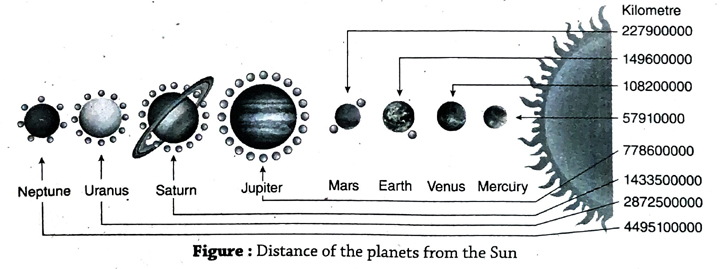
2. Describe the Earth as a planet.
Ans. Earth as a planet: The Earth is an important planet in the solar system. The features of the Earth as a planet are as follows-
- Location: The Earth is the third planet on the basis of its distance from the Sun, after Mercury and Venus.
- Distance from the Sun: The average distance of the Earth from the Sun is 149.6 million kilometre.
- Shape: The shape of the Earth is like an oblate spheroid. The North and South Poles are flattened and the equatorial region bulges out a little.
- Mass and area: The mass of the Earth is about 5.97219 x 1024 kg and surface area is about 510,072,000 square km.
- Diameter: The Earth’s equatorial diameter is 12,757 km and the polar diameter is 12,714 km (approx.).
- Speed: The Earth revolves around the Sun while rotating on its own axis. It takes 23 hours 56 minutes and 4 seconds to complete one rotation on its axis and 365 days 5 hours 48 minutes and 46 seconds to complete one revolution around the Sun.
- Orbit: The Earth’s orbit is elliptical. The length of the orbit is about 960 million km.
- Satellite: The Earth has only one satellitethe Moon. The Moon is at a distance of about 3,84,400 km from the Earth. It has no light of its own- it is illuminated by the light of the Sun.
- Structure: The exterior of the Earth is made up of hard rocks and its interior is made up of hot, viscous magma. About 71% of the Earth’s surface is made up of water and 29% is land. The Earth’s atmosphere is primarily made up of nitrogen and oxygen.
- Sustenance of life: The Earth is the only planet in the solar system that sustains life as we know it.
3. Give a brief note on GPS. How does the GPS help in understanding the shape of the Earth?
Ans. GPS: The Global Positioning System (GPS) is a radio-based navigation system that is able to locate the exact position of someone or something on Earth, at any time. A further elaboration of the system is:
- Location: Several artificial satellites have been launched in space to orbit the Earth at an altitude of about 20,200km. The functioning of GPS requires a minimum of four artificial satellites.
- Components: GPS consists of three major parts. They are- (1) the space segment, (2) the control segment, and (3) the user segment.
- Information: GPS is mainly capable of providing four types of information about a place. They are- (1) ‘X’=Latitude, (2) ‘Y’ = Longitude, (3) ‘Z’ = Altitude and (4) ‘T’ = Time.
- Usage: Though GPS was first developed in the USA in the 1970s by the U.S. Department of Defence for military purposes, but the use of GPS for everyday became common from the 1990s. This system helps us to- (1) find out the exact location of a place on the Earth’s surface, (2) find out the average elevation of a place, (3) determine the direction of flying aircrafts and sailing ships and (4) make maps for various development projects.
Application of GPS in understanding the shape of the Earth: As the receiver of the GPS on the surface of the Earth receives the signals sent from the artificial satellites positioned in space, the exact position on Earth can be determined. The GPS signals are so accurate and powerful that even a small variation in height can be easily determined. The following example will further explain this
For instance, say three points (A, B and C) are marked at a distance of 10m from each other on the same latitude. The GPS information from all these places are noted, where, ‘X’= Latitude, ‘Y’ = Longitude, ‘Z’ = Altitude and ‘T’ = Time.
| Place |
X |
Y |
Z |
T |
| A |
22° N |
86° E |
6 m |
9:10 a.m. |
| B |
22° N |
86° E |
7 m |
9:12 a.m. |
| C |
22° N |
86° E |
6.5 m |
9:14 a.m. |
A graphical representation of the entire data will give us a clear picture of the variation of the height of the points studied.
4. Write a note on the uses of GPS.
Ans. The uses of GPS: The Global Positioning System (GPS) is a radio-based navigation system that is able to locate the exact position of an object on Earth, anytime and anywhere. The applications of GPS are as follows-
- Town planning: Nowadays, GPS is used for town planning in most of the urban areas.
- Shape of the Earth’s surface: GPS is used to determine the shape of the Earth’s surface.
- Distance and ruggedness: GPS is used to determine the difference in distances and ruggedness between two places on the surface of the Earth.
- Transportation system: GPS is useful for determining the direction in order to fly aircrafts and sail ships or even for determining road routes to different places.
- Defence: Currently, GPS is used to track movement and carry out rescue operations by defence forces. GPS helps in tracking any aircraft or ship that has met with an accident or has gone missing.
- Geometric location: The geometric location of any object on the surface of the Earth can be traced with the help of GPS.
- Weather: Information on weather can be found through the use of GPS and dependable forecasts can be made on the same basis.
- Cartography: Cartography becomes easier, more informative and more accurate if drawn on a computer using data gathered from GPS.
5. ‘Earth is the abode of man.’ Explain. Or, Describe why life has been found only on Earth instead of all the other planets in the solar system.
Ans. Reasons why life has been found only on Earth instead of all the other planets in the solar system: Among all the planets in the solar system, the Earth is the only planet where life exists. This is because of suitable living conditions on Earth. So, Earth has become the home for human and other living organisms. The reasons for this are as follows-
- Suitable temperature: The Earth receives light and heat from the Sun. Some of it is retained and the rest is reflected back by the atmosphere. This helps to regulate the temperature of the Earth and maintain it at an average of 15°C, which is suitable for life. Both the planets that are nearer to the Sun (such as Mercury and Venus) and planets farther away from the Sun (such as Jupiter and Saturn) cannot sustain life because either they are too hot or too cold.
- Abundant availability of water: Existence of life is not possible without water. Water constitutes 71% of the Earth’s surface. This is another major reason for the existence of life on Earth. No traces of water have been found on other planets like Jupiter or Venus.
- Availability of oxygen: Oxygen content in the Earth’s atmosphere is about 21%. Oxygen is needed to survive, because it helps to breathe. Earth is the only planet where the oxygen content in the atmosphere is about 21%, that is helpful for the sustenance and growth of life.
- Availability of food: The Earth’s environment is favourable for growing food. All the necessary elements such as soil, sunlight, water, gaseous elements (0 and N), mineral components (Fe, Cu) are found in suitable proportions on Earth. The green plants make their food from these elements and the food chain continues.
- Abundance of sunlight: Sun is the source of all known energy, and life is not possible without sunlight. The first link of any food chain the autotrophs, use solar energy to produce their food.
- Other factors: Life has become possible on Earth also because of the following reasons- (1) Right proportion of gases in the atmosphere, (2) weather elements such as formation of clouds, rain, wind flow and others, (3) occurrence of day and night, (4) occurrence of seasons and various other factors.
Short Explanatory Answer Type Questions
1. State the similarities and dissimilarities between dwarf planets and satellites.
Ans. The similarities between dwarf planets and satellites are as follows-
- Size: Both dwarf planets and satellites are relatively small in size.
- Light and heat: Neither dwarf planets nor satellites emit light or heat of their own.
- Movement: Both have rotation and revolution.
The dissimilarities between dwarf planets and satellites are as follows-
- Revolution: The dwarf planets revolve around the Sun, whereas the satellites revolve around their individual, specific planets of origin.
- Number: The number of dwarf planets is much less compared to the number of satellites.
- Path: Revolutionary path of dwarf planets are bigger than the satellites.
2. Why is the Earth considered to be a planet of the solar system?
Ans. The Earth is considered to be a planet of the solar system because of the following reasons
- Origin: The Earth like all other planets is believed to have originated from the star of the solar system, the Sun.
- Revolution: Like the other planets of the solar system (such as Venus, Jupiter), the Earth also revolves around the Sun on its own orbit.
- Heat and light: Like the other planets of the solar system, the Earth too, does not emit any light and heat.
- Gravitational power: Like the other planets of the solar system, the Earth also has gravitational power.
3. Why has Pluto been classified as a dwarf planet?
Ans. One of the characteristics that define planets is that they have enough gravitational force to dominate their neighbourhoods, by clearing up the debris near their orbits. Pluto’s orbit is still somewhat cluttered. Pluto is just 0.07 times the mass of the other objects in or near its orbit and there are still many objects similar in size to Pluto moving around its orbit. Also, the orbit of Pluto is not well-defined. It at times enters the orbit of Neptune. Moreover, Pluto is the smallest planet in the solar system. It is only about one-tenth of the size of the Earth. Hence, on August 24, 2006, the International Astronomical Union classified Pluto as a dwarf planet.
4. Why is the average distance between the Earth and the Sun not the same throughout the year?
Ans. The Earth revolves around the Sun in an elliptical orbit. As the Sun is located at one of the focus of the ellipse, the distance of the Earth from the Sun varies during its period of revolution. The distance of the Earth is maximum on 4 July, when it is 152.6 million kilometre away, and minimum on 3 January, when it is 147.5 million kilometre away from the Sun. If the orbit would have been a perfect circle, the distance between the Earth and the Sun would have remained the same throughout.
5. Give a brief description of biosphere.
Ans. The sum of all ecosystems on Earth is known as biosphere. This includes all the parts of the atmosphere, lithosphere and hydrosphere that are suitable for the sustenance of life. Water, sunrays and the proper structure of the atmosphere has made life possible on Earth, and has also supported the wide range of flora and fauna. The range of the biosphere generally extends from a height of 15 km above the Earth’s surface to about 9 km below the sea level in the hydrosphere. Right from the creation of life, various evolutions are taking place in the biosphere that has supported its expansion. Till date the Earth is the only planet in the solar system where the existence of life can be found.
6. How is the Earth unique among all the other planets in the solar system?
Ans. The Earth is unique among all the other planets in the solar system because of the following reasons-
- It is the largest among all the inner planets.
- The distance of the Earth from the Sun is exactly suitable for sustenance of life on Earth.
- The Earth is the only planet to have water and so is rightly named the ‘Blue Planet’.
- The rotational and revolutional movement of the Earth along with its axial tilt of 66½° helps to maintain the temperature balance on places all over the Earth.
- The average temperature on the surface of the Earth is about 15°C, which is suitable for the growth and sustenance of life.
7. Explain what the Earth looks like from what the farth looks like from space.
Ans. From space, the Earth looks like a blue sphere due to the presence of excess water (about 71%). There are white spots around both Poles because of ice, green spots for the forests and grey spots for the deserts, hills and mountains. As the predominant colour of the Earth is blue, so the Earth appears as a ‘Blue Planet’ from space. But the surface of the Earth seems like a rough terrain because of the presence of mountains, plains and plateaus.
8. How did the Greek scholar Eratosthenes calculate the circumference of the Earth?
Ans. In the third century BC, Eratosthenes was the first person who calculated the size of the Earth, with an assumption that the Earth is a perfect sphere. Eratosthenes observed that on 21 June (Summer Solstice), the Sun in Syene (23½°N) is exactly vertical at noon. On the same day in Alexandria (30½°N), the angle between the sunrays and the vertical line was 7°12′. Now, 7°12′ is (360°/ 7°12′) = 1/50 part of the circumference of the Earth. Eratosthenes had already calculated the actual distance between Alexandria and Syene, which he found to be
5000 stadia. From these, he calculated the circumference of the Earth to be 5000 stadia x 50 = 2,50,000 stadia, or 46,250 km. (But, now the circumference of the Earth has been measured to be 40,075 km.)
9. Why from the Earth the Moon appears bigger than all other heavenly objects in the sky, though it is smaller?
Ans. When we look up at the sky, the Moon appears to be the largest object in space. In reality, the Moon is much smaller in size than the other planets, satellites and stars. In fact, it is only about 1/50th of the Earth’s size. However, being the Earth’s only satellite, it is also our nearest neighbour in space. The distance between the Moon and the Earth is only 3,84,400 kilometre. So it appears larger than all other celestial bodies which are much larger, but are at greater distances from the Earth.
Short Answer Type Questions
1. What is meant by the solar system?
Ans. Solar system is the name given to the Sun and the various planets, satellites, comets, asteroids and other heavenly bodies, that are moving around the Sun in their unique and specific orbits.
2. Name the planets of the solar system.
Ans. The planets of the solar system are-
1. Mercury, 2. Venus, 3. Earth, 4. Mars, 5. Jupiter, 6. Saturn, 7. Uranus, and 8. Neptune.
3. What is meant by a star?
Ans. A star is a gigantic, self-luminous heavenly body made of burning gases. Other celestial bodies such as planets, satellites, comets and asteroids revolve around a star. For instance, the Sun is the largest star of our solar system.
4. What is meant by a planet?
Ans. A planet (word derived from Greek term that means ‘wanderer’) is a large heavenly body that revolves in a particular orbit around a star. A planet does not radiate heat or light energy from internal nuclear fusion reactions. It receives heat and light from the star that it revolves around. For instance, our Earth is a planet that revolves around its star, the Sun.
5. What is meant by a satellite?
Ans. A satellite is a small heavenly object that orbits or revolves around a planet. Like planets, satellites also do not radiate heat or energy from internal nuclear fusion reactions. All the planets in the solar system have satellites, except Mercury and Venus. For instance, the Moon is a satellite that orbits around its planet, the Earth.
6. What is meant by a dwarf planet?
Ans. According to the International Astronomical Union (IAU), a dwarf planet is a celestial body that orbits a star, has enough mass to assume a nearly round shape but can not clear the neighbourhood around its orbit. Also, doesn’t have a well-defined orbit of its own.
7. Why is the Earth called the ‘Blue Planet’?
Ans. From space, the Earth appears as a blue ball.. About 71% of the Earth’s surface is water. As almost three-fourths of the Earth is covered with water, it appears mostly blue from space. This is why the Earth is known as the ‘Blue Planet’.
8. What is galaxy?
Ans. A Galaxy is a huge collection of gaseous clouds, dust, billions of stars and their solar systems, that are held together by gravity. Galaxies are spiral, oval or of various other shapes. The milky way is one such spiral galaxy to which our solar system belongs.
9. Which are the inner planets of our solar system?
Ans. The first four planets of our solar system, Mercury, Venus, Earth and Mars are closer to the Sun and they are comparatively small in size. Hence these planets are called inner planet.
10. Which are the outer planets?
Ans. The last four planets of our solar system i.e., Jupiter, Saturn, Uranus and Neptune are the farthest planets from the Sun. These planets are called outer planets. The orbits of these planets are lying outside the asteroid belt and the size of these planets are comparatively large than rest of the planets of our solar system.
11. What is meant by GPS?
Ans. The Global Positioning System (GPS) is a radio-based navigation system that provides a three dimensional coverage of the Earth in any weather condition. Till date, it is the only system which is able to show one’s exact position on Earth-any time and anywhere.
12. In which part of the world did GPS first come into use?
Ans. GPS was first developed and implemented in the USA in the 1970s by the US Department of Defence and was used only for military purposes.
13. What information can be gathered from a GPS receiver?
Ans. The information that can be gathered from a GPS receiver are –
- A GPS receiver operated by an user on Earth, measures the time taken by the radio signals to travel from four or more satellites to its location. Once the receiver calculates its distance from the satellites, it can figure out the exact position of the user by determining the latitude, longitude and altitude.
- A GPS receiver also displays time. GPS satellites have atomic clocks that show accurate time.
Multiple Choice Type Questions [MCQ type]
Write the correct answer from the given alternatives
1. The ‘Blue Planet’ is another name for-
A. Earth
B. Saturn
C. Venus
D. Mars
Ans. A
2. The planet nearest to the Earth is-
A. Mercury
B. Venus
C. Mars
D. Jupiter
Ans. B
3. The planet closest to the Sun is-
A. Mercury
B. Venus
C. Pluto
D. Neptune
Ans. A
4. “The Earth revolves around the Sun and on its own axis.” The first person to say this was-
A. Copernicus
B. Aryabhatta
C. Galileo
D. Newton
Ans. A
5. The average distance of the Earth from the Sun is-
A. 140 million km
B. 150 million km
C. 160 million km
D. 120 million km
Ans. B
6. An example of a dwarf planet is-
A. Pluto
B. Mercury
C. Mars
D. Neptune
Ans. A
7. The average radius of the Earth is-
A. 6,300 km
B. 6,371 km
C. 6,500 km
D. 6,600 km
Ans. B
8. In 1797, scientist Henry Cavendish determined the Earth’s-
A. density
B. weight
C. circumference
D. diameter
Ans. B
9. In terms of distance from the Sun, the Earth is …….. planet.
A. second
B. third
C. fourth
D. fifth
Ans. B
10. The Sun is a-
A. planet
B. satellite
C. star
D. galaxy
Ans. C
11. The Sun is heavier than the Earth by
A. 0.35 million times
B. 0.33 million times
C. 0.325 million times
D. 0.32 million times
Ans. B
12. The number of Jovian planets in the solar system is
A. 7
B. 8
C. 9
D. 6
Ans. B
13. The planet which has rings around it is-
A. Saturn
B. Earth
C. Mercury
D. Venus
Ans. A
14. The name of one satellite of Saturn is-
A. Moon
B. Titan
C. Phobos
D. Haumea
Ans. B
15. The total number of components in a GPS is-
A. 3
B. 4
C. 6
D. 5
Ans. A
16. The shape of Mercury and Venus is-
A. oblate spheroid
B. perfect sphere
C. geoid
D. flattened
Ans. B
17. To complete one revolution around the Sun, Venus takes-
A. 365 days
B. 24 hours
C. 243 days
D. 27 days
Ans. C
18. To complete one revolution around the Earth, the Moon takes-
A. 36 days
B. 20 days
C. 27 days
D. 271/3 days
Ans. D
19. The length of the Earth’s orbit is-
A. 9.6 million km
B. 11 million km
C. 14.70 million km
D. 15.20 million km
Ans. A
20. To determine the location of any place on Earth using GPS, the number of satellites launched in space by the USA is-
A. 23
B. 24
C.25
D. 31
Ans. A
Very Short Answer Type Questions
Fill in the blanks with suitable words
1. The first person to calculate the circumference of the Earth was ……..
Ans. Eratosthenes
2. In terms of size, the Earth stands ………. among the planets of the solar system.
Ans. fifth
3. The Sun is ………. times larger in size than the Earth.
Ans. 1.3 million
4. The only satellite of the Earth is the ……….
Ans. Moon
5. The Moon is at a distance of about ……… km from the Earth.
Ans. 3,84,400
6. The Sun and the heavenly objects that revolve around it are together known as the ……….
Ans. solar system
7. The satellites used for GPS are generally at a distance of ……….. km from the Earth’s surface.
Ans. 20,200
8. The who first succeeded person in estimating the volume of the Earth was ……….
Ans. Aristotle
9. One stadia is equal to ………. metres.
Ans. 185
10. The Earth appears ………… in colour from space.
Ans. blue
11. ………. estimated the circumference of the Earth on the basis of the angle of incidence of the Sun’s rays.
Ans. Eratosthenes
12. The planet closest to the Sun is ………….
Ans. Mercury
13. The largest planet of the solar system is …………
Ans. Jupiter
14. The movement of the Earth around the Sun is called its …………..
Ans. revolution
15. Jupiter has ……….. satellites.
Ans. 67
If the statement is true, write ‘T’ and if false, write ‘F’ against the following
1. The Moon does not have any light of its own.
Ans. T
2. The Earth, along with other planets, moves around the Sun.
Ans. T
3. The Earth is the only planet in the solar system known to support life.
Ans. T
4. Stars do not have light of their own.
Ans. F
5. Artificial satellites are used to gather information for use by GPS.
Ans. T
6. The main control system of GPS is in the United States of America.
Ans. T
7. According to circumference Eratosthenes, the of the Earth is 2,50,000 stadia.
Ans. T
8. Eris is a planet.
Ans. F
9. Planets are smaller than dwarf planets.
Ans. F
10. The southern hemisphere has a greater percentage of landmass.
Ans. F
11. Mercury’s shape is like that of the Earth.
Ans. F
12. The Earth’s circumference was calculated by Ptolemy.
Ans. F
13. The average circumference of the Earth is about 40,000 km.
Ans. T
14. With the help of GPS, we have come to know the exact shape of the Earth.
Ans. T
15. The Earth’s orbit is 960 million km and its shape is circular.
Ans. F
16. Jupiter has two satellites.
Ans. F
17. The dwarf planet Eris has 10 satellites.
Ans. F
18. It is because of the presence of the atmosphere that only the white ray from the Sun reaches the Earth’s surface.
Ans. T
19. The Earth and other planets move around the Sun due to the effect of gravitational force.
Ans. T
20. Biosphere is extended upto 15km altitude in the atmosphere.
Ans. T
Answer in one or two words
1. How many true planets are there in the solar system?
Ans. 8.
2. What is the area of the Earth’s surface?
Ans. Almost 510.72 million sq km.
3. Name two planets that do not have satellites.
Ans. Mercury and Venus.
4. Which planet has the most number of satellites?
Ans. Jupiter.
5. What is the estimated mass of the Earth?
Ans. 5.97219 × 1024 kg.
6. How much time does the light of the Sun take to reach the Earth?
Ans. 8.2 minutes.
7. What was the circumference of the Earth according to Eratosthenes?
Ans. 46,250 km.
8. Name one Jovian planet.
Ans. Mars.
9. What is the only source of light in the solar system?
Ans. Sun
10. What is the full form of GPS?
Ans. Global Positioning System.
11. How can the planets of the solar system be classified?
Ans. Planets and dwarf planets.
12. What are the two satellites of Mars?
Ans. Fobos and Demos.
13. What is the minimum number of satellites required to operate GPS?
Ans. 3.
14. Name the three major components of GPS.
Ans. The space segment, the control segment and the user segment.
15. Which planet was designated as a dwarf planet in 2006?
Ans. Pluto.
16. Which heavenly body is at the centre of the solar system?
Ans. The Sun.
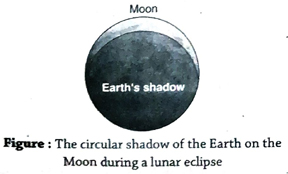 stands to reason that the object itself is also circular in shap
stands to reason that the object itself is also circular in shap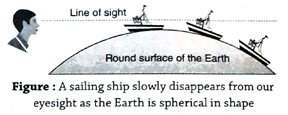 after some time even with the help of binoculars or telescopes. This happens because of the curvature of the Earth’s surface. If the Earth would have been a flat plane, the ship would never disappear from our line of sight.
after some time even with the help of binoculars or telescopes. This happens because of the curvature of the Earth’s surface. If the Earth would have been a flat plane, the ship would never disappear from our line of sight.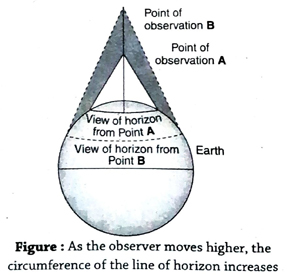 mountain, the visible horizon becomes more distant and its circumference seems to increase. As a result of which the line of horizon appears circular. If the Earth would have been a flat plane, the circumference of the line of horizon would not increase with increase in altitude of the position of the observer; instead, it would have remained the same.
mountain, the visible horizon becomes more distant and its circumference seems to increase. As a result of which the line of horizon appears circular. If the Earth would have been a flat plane, the circumference of the line of horizon would not increase with increase in altitude of the position of the observer; instead, it would have remained the same.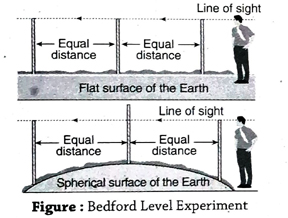 telescope, he then observed that the second stick seemed to be higher than the first and third sticks. This proved that the Earth is round. If the Earth would have been flat, the tops would have been in a straight line.
telescope, he then observed that the second stick seemed to be higher than the first and third sticks. This proved that the Earth is round. If the Earth would have been flat, the tops would have been in a straight line.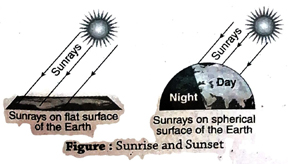 If the Earth would have been flat then sunrise and sunset would have occured at the same time at all places on the Earth.
If the Earth would have been flat then sunrise and sunset would have occured at the same time at all places on the Earth.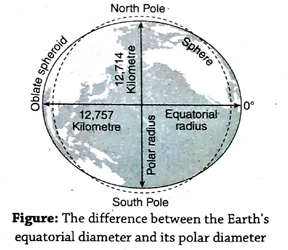 have been a perfect sphere, then both the diameters would have been the same.
have been a perfect sphere, then both the diameters would have been the same.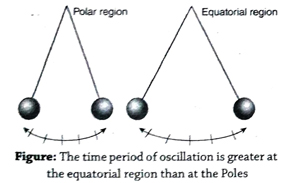
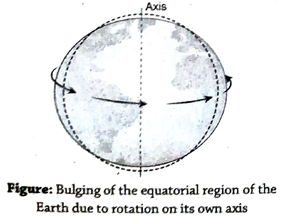 the same time, the polar areas flatten. The Earth is continuously rotating on its axis from the time of its origin. This is why the Earth has become an oblate spheroid in shape.
the same time, the polar areas flatten. The Earth is continuously rotating on its axis from the time of its origin. This is why the Earth has become an oblate spheroid in shape.